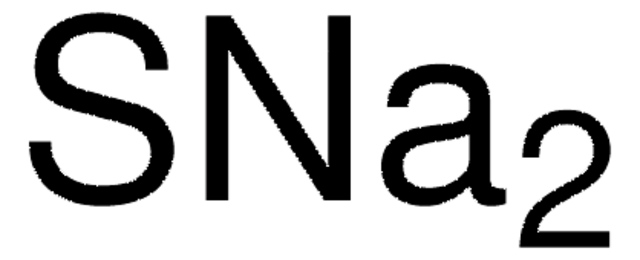203890
Nickel(II) sulfate heptahydrate
99.999% trace metals basis
Synonyme(s) :
Nickel sulfate heptahydrate, Nickelous sulfate heptahydrate
About This Item
Produits recommandés
Niveau de qualité
Pureté
99.999% trace metals basis
Forme
crystals and lumps
Impuretés
≤15.0 ppm Trace Metal Analysis
Densité
1.948 g/mL at 25 °C (lit.)
Application(s)
battery manufacturing
Chaîne SMILES
[Ni++].[H]O[H].[H]O[H].[H]O[H].[H]O[H].[H]O[H].[H]O[H].[H]O[H].[O-]S([O-])(=O)=O
InChI
1S/Ni.H2O4S.7H2O/c;1-5(2,3)4;;;;;;;/h;(H2,1,2,3,4);7*1H2/q+2;;;;;;;;/p-2
Clé InChI
OGKAGKFVPCOHQW-UHFFFAOYSA-L
Vous recherchez des produits similaires ? Visite Guide de comparaison des produits
Description générale
Application
- As a vital precursor to generate nickel-rich cathode materials (NMC, NCA) for lithium-ion batteries using co-precipitation process because of its simplicity, ease of scale-up, and ability to produce a homogeneous structure at the particle scale.
- As a nickel source in the electrodeposition process to fabricate the Ni-NTNW (nickel nanotube network), which is then coated with the electroactive NiCo-LDH material to form the hierarchical supercapacitor electrode.
- As a precursor to synthesize the nickel(II) cinnamate complex, which is a key component in the preparation of the metal chelate monomers.
- To synthesize a highly efficient oxygen evolution reaction (OER) trimetallic Fe-Co-Ni electrocatalyst with other metal sulfates .
- To synthesize high entropy alloy for coatings to improve hardness, wear resistance and corrosion resistance.
Caractéristiques et avantages
- High purity with trace metal analysis (=< 15 ppm) for 32 elements, suitable for batteries.
- High water solubility ideal for synthesizing composites for various applications.
- Low ppm levels of metal ions including Al, K, Na, Mg, Cu, Co, etc.,7) 99.999% purity is ideal for nickel plating.
Mention d'avertissement
Danger
Mentions de danger
Conseils de prudence
Classification des risques
Acute Tox. 4 Inhalation - Acute Tox. 4 Oral - Aquatic Acute 1 - Aquatic Chronic 1 - Carc. 1A Inhalation - Muta. 2 - Repr. 1B - Resp. Sens. 1 - Skin Irrit. 2 - Skin Sens. 1 - STOT RE 1 Inhalation
Organes cibles
respiratory tract irritation
Code de la classe de stockage
6.1D - Non-combustible acute toxic Cat.3 / toxic hazardous materials or hazardous materials causing chronic effects
Classe de danger pour l'eau (WGK)
WGK 3
Point d'éclair (°F)
Not applicable
Point d'éclair (°C)
Not applicable
Équipement de protection individuelle
dust mask type N95 (US), Eyeshields, Faceshields, Gloves, type P2 (EN 143) respirator cartridges
Faites votre choix parmi les versions les plus récentes :
Déjà en possession de ce produit ?
Retrouvez la documentation relative aux produits que vous avez récemment achetés dans la Bibliothèque de documents.
Les clients ont également consulté
Articles
In many technologies, performance requirements drive device dimensions below the scale of electron mean free paths (λe). This trend has increased scientific interest and technological importance of electrical resistivities at the nanoscale.
Lithium-ion batteries represent a group of electrochemical devices used for electricity storage and have attracted a lot of attention in the past two decades due to their portability, rechargeability and low cost.
Plasmonic nanoparticles have unique optical properties that can be tailored to suit a variety of applications in the biotechnology1–8 and electronics9–16 industries.
Notre équipe de scientifiques dispose d'une expérience dans tous les secteurs de la recherche, notamment en sciences de la vie, science des matériaux, synthèse chimique, chromatographie, analyse et dans de nombreux autres domaines..
Contacter notre Service technique



